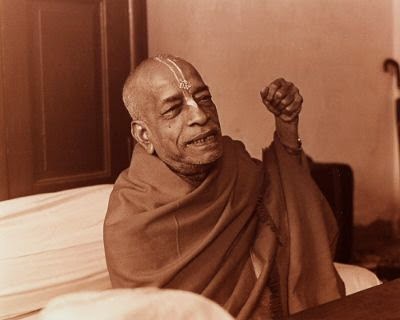
Clearing a Few More Misconceptions about Rāgānugā Sādhana.
There seems to be a lot of interest in my previous article on the subject, and some discussion has cropped up, which makes me realize there are many other misconceptions about Rāgānugā-Sādhana that gradually have to be addressed before anyone can gain a clear, confident, and wise understanding of Śrī Rūpa’s blessings to the world.
No Rules
The biggest misconception is that Vaidhi follows rules, but Rāgānugā doesn’t. That’s just wrong. BRS 1.2.296 and 1.2.101 prove that it is a misconception. The difference between the two sādhanas in this regard is simply that Vadhi is motivated by the desire to follow God’s rules, where Rāgānugā is motivated by desire to love God in a very intimate way – and it utilizes rules and methodologies as tools to attain that intimate love.
Any so called bhakti that doesn’t follow śāstra is “bogus-bhakti”, not ”rāgānugā-bhakti.”
”Spontaneous”
A similar misconception is that the execution of rāgānugā is “spontaneous” (and therefore doesn’t follow rules).
It is true that rāgānugā is svabhāvikī (natural, spontaneous). But it is bhāva-bhakti which begins to be svabhāvikī in execution. Rāgānugā-bhakti is svabhāvikī (spontaneous) in its motivation, not in its execution. This is proven by BRS 1.2.291 and 292 as well as by Śrī Viśvanātha Cakravarti’s explanation of ŚB 3.25.32.
“Spontaneous motivation” specifically means that you have a natural, undeniable interest in pursuing a specific type of intimate relationship with Krishna. You don’t get this interest because you theoretically know its a good thing to have, or because someone says you are supposed to have it – you just have it naturally (as a result of having heard a particularly beautiful līlā which awakens your specific attachment to the love demonstrated in that līlā)
One should note carefully that all the original archetypes of rāgānugā-sādhana — for example the six goswāmīs — rigidly observed vratas and vidhis, like counting a certain number of recitations of mahāmantra on beads daily, daily offering a certain number of praṇām to people, limiting very strictly their sense-gratification, and so on. ”saṁkhya pūrvaka nāma… Not that they just did whatever they wanted whenever they felt spontaneously inspired to do it.
Rāgānugā is just About the Motivation
Rāgānugā is based on spontaneous motivation, but it also differs from vaidhi-sādhana in the ways described in BRS 1.2.294 and 295: that the focus is on the internal significance of ones external deeds.
Basically, in vaidhi-sādhana we see the external deed as the whole package. “OK I did 16 rounds today.” Or, “OK I offered the chapattis to Krishna.” But in rāgānugā-sādhana we are mainly focused on the internal significance of the deeds. While chanting 16 rounds we are praying to become freed from our imperfections that keep us from attaining a specific intimate loving relationship with Krishna. Externally we may be sitting in front of an altar with marble deities, but internally we are sitting in our rooms, behind locked doors with mother-in-laws and husbands blocking all the exits so that we cannot leave and answer the flute’s call, so we are chanting the name, because that is all we have, and the fire the name ignites in us, will burn the impurities that cause us to be so blocked.
Or we may be meditating that Rādhā and Krishna have come to sit privately with us and hear us privately express our love for them by reciting their names with attention and focus. In this way, whatever the specifics, there is some internal significance to the external deed, and the internal significance is nourishing to the particular mood one aspires for. These are example of Rāgānugā relevant to mādhurya-rati. Every individual Rāgānugā-sādhaka will have different internal significance in their external practices. But the key is that the rāgānugā-sādhaka is focused FIRST of all on the internal aspect, and the external aspect is facilitating the internal meditation.
Kāmānugā is the variety of Rāgānugā inspired by the the hope of attaining a love for Krishna like the gopīs have. Sambandhānugā is the variety of Rāgānugā that is inspired by the hopes of attaining other relationships. So, one inspired by the hope of attaining a motherly relationship with Krishna could offer capatis to the deity just like any vaidhi-bhakta, but the internal activity going on which externally offering chapatti on an altar may be that she has taken chapati that Rādhārāṇī cooked on Yaśodā-devī’s request, and is carrying it into the dining area where Krishna is seated with his father and brother and some of their friends, and is serving the chapati to them as they joke, etc.
So, Rāgānugā is not just about having a spontaneous motivation to attain a particular loving relationship with Krishna, it is also about practicing the vidhis in a way that facilitates achieving that relationship.
Rāgānugā Sādhana Naturally Happens When You Are Purified by Vaidhi
I think this is a useful thing to explain to someone who is overly zealous to imitate rāgānugā-sādhana when factually they have no inclination to love Krishna in any mood, but are only inclined to be loved and adored by others. It is useful because it puts the person “in his place” and makes him focus on more honest bhakti. However it is not an objective philosophical fact that Vadhi leads to Rāgānugā.
The objective fact is that Vaidhi-sādhana leads to vaidyottara-bhāva-bhakti which blossoms as maryāda-prema. On the other hand rāgānugā-sādhana leads to rāgottara-bhāva-bhakti which blossoms as kevala-prema. The two paths don’t cross at any time.
If you don’t have spontaneous inspiration to love Krishna in a particular way, and you want to get it, you won’t get it by “following vaidhi-sādhana — but you can get it by following BRS 1.2.296, which means to adopt an approach to rāgānugā-sādhana which relies very heavily on the vidhis common to vaidhi-sādhana but under the guidance of a rāgānugā-guru who aims your vidhi towards exposure to kīrtan of the nāma, rūpa, guṇa and līlā of Krishna in a genuine, pure way. By that exposure we soon get the initial spark of spontaneous inspiration, and then be able to proceed more towards BRS 1.2.294 and 295.
This is exactly the system our Guru, Śrīla Prabhupāda, set up as the ideal for ISKCON, but a lot of his followers seem not to understand it, and mistake his program as vaidhi-bhakti.
As shown in BRS 1.2.309 the ultimate cause is the mercy of Krishna’s devotee who has some spontaneous love, or aspiration for spontaneous love, at least. For its really only when we hear kīrtan of the nāma, rūpa, guṇa and līlā by someone who really loves Krishna that we stand any chance of any of that love inspiring us to attain something similar.
Thus we are very fortunate to have Śrī Bhāgavata (spoken by Śuka, who is full of prema), and we are very fortunate to have explanations of the Bhāgavata by the Goswāmīs and their followers. We are very fortunate that Śrī Bhaktivinoda prepared the way for sharing this loving access to Krishna-līlā with the modern, Westernized world. And we are very fortunate that Śrīla Bhaktisiddhānta and Śrīla Bhaktivedānta Swāmī Prabhupāda have furthered that work. Especially we are lucky for all the writings Śrīla Prabhupāda left for us. Because its by hearing about Krishna from someone who really loves Krishna that we hope to catch the spark of spontaneous inspiration to also love Krishna.
We should always be looking everywhere and anywhere for someone who can speak about Krishna with genuine love. Finding such person we should open our ears wide! I am most fortunate to have been able to meet pure devotees in this very lifetime, and to hear from them with open ears. I don’t know how this was possible.
You Can Understand Rāgānugā by Debating About it
The “cool” and “advanced” club is well outside the umbrella of pure devotional service, and far below the feet of even the simplest sincere vaidhi-bhakta. You can’t get anywhere near Vṛndāvana Krishna by feeling smarter, better, more advanced than other people.
The person who debates more forcefully or with more bravado then the next, is not the person we want to align ourselves with, unless we want to follow them into their karmic spiral.
As your servant and a mere sweeper in the gutter of the Gauḍiya Paramparā, I offer whatever feeble services I can to any and all who request or avail of it. There is no need to debate with hotheaded people who already feel convinced they know everything there is to know. Better to sign a document consenting defeat to such persons, and assemble sincere seekers of Krishna in a private place, and carefully discuss the teachings of our guides and exemplars.
To purify myself I have taken this opportunity to discuss the wonderful subject of Rāgānugā Sādhana. Holding to my chest and on my head the stones from the places where followers of Śrī Rūpa have walked, I tend to remain a fool.







 Another story that I have about Brahmananda – once in Vrindavan, Madhudvisa, another sannyasi, arranged that a picture would be taken. This picture was a group photo of devotees in ISKCON and Madhudvisa organized it all, with everybody nicely in the right position.
Another story that I have about Brahmananda – once in Vrindavan, Madhudvisa, another sannyasi, arranged that a picture would be taken. This picture was a group photo of devotees in ISKCON and Madhudvisa organized it all, with everybody nicely in the right position.















